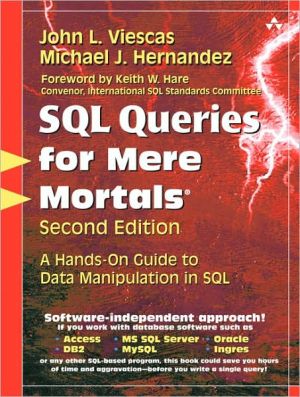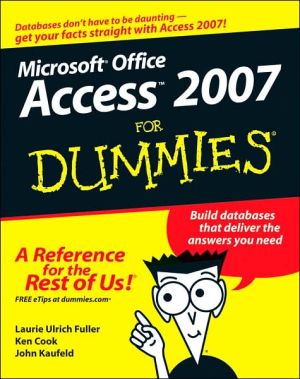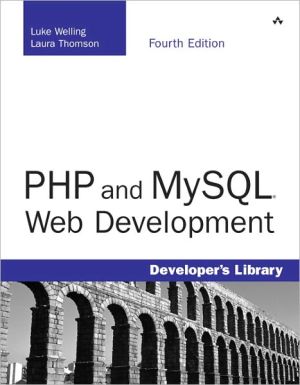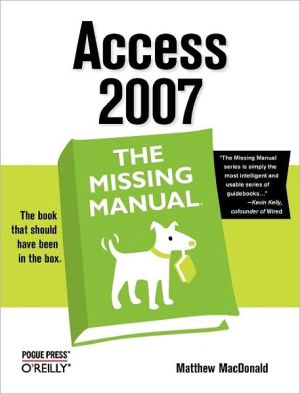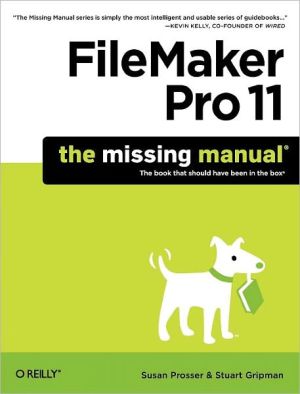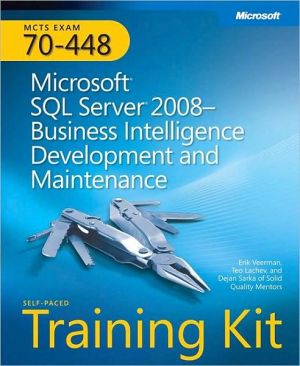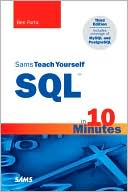SQL Queries for Mere Mortals: A Hands-on Guide to Data Manipulation in SQL [For Mere Mortals Series]
Unless you are working at a very advanced level, this is the only SQL book you will ever need. The authors have taken the mystery out of complex queries and explained principles and techniques with such clarity that a "Mere Mortal" will indeed be empowered to perform the superhuman. Do not walk past this book!\ --Graham Mandeno, Database Consultant\ SQL Queries for Mere Mortals provides a step-by-step, easy-to-read introduction to writing SQL queries. It includes hundreds of examples with...
Search in google:
Unless you are working at a very advanced level, this is the only SQL book you will ever need. The authors have taken the mystery out of complex queries and explained principles and techniques with such clarity that a "Mere Mortal" will indeed be empowered to perform the superhuman. Do not walk past this book!—Graham Mandeno, Database ConsultantSQL Queries for Mere Mortals provides a step-by-step, easy-to-read introduction to writing SQL queries. It includes hundreds of examples with detailed explanations. This book provides the tools you need to understand, modify, and create SQL queries—Keith W. Hare, Convenor, ISO/IEC JTC1 SC32 WG3—the International SQL Standards CommitteeI learned SQL primarily from the first edition of this book, and I am pleased to see a second edition of this book so that others can continue to benefit from its organized presentation of the language. Starting from how to design your tables so that SQL can be effective (a common problem for database beginners), and then continuing through the various aspects of SQL construction and capabilities, the reader can become a moderate expert upon completing the book and its samples. Learning how to convert a question in English into a meaningful SQL statement will greatly facilitate your mastery of the language. Numerous examples from real life will help you visualize how to use SQL to answer the questions about the data in your database. Just one of the "watch out for this trap" items will save you more than the cost of the book when you avoid that problem when writing your queries. I highly recommend this book if you want to tap the full potential of yourdatabase.—Kenneth D. Snell, Ph.D., Database Designer/ProgrammerI don't think they do this in public schools any more, and it is a shame, but do you remember in the seventh and eighth grades when you learned to diagram a sentence? Those of you who do may no longer remember how you did it, but all of you do write better sentences because of it. John Viescas and Mike Hernandez must have remembered because they take everyday English queries and literally translate them into SQL. This is an important book for all database designers. It takes the complexity of mathematical Set Theory and of First Order Predicate Logic, as outlined in E. F. Codd's original treatise on relational database design, and makes it easy for anyone to understand. If you want an elementary- through intermediate-level course on SQL, this is the one book that is a requirement, no matter how many others you buy.—Arvin Meyer, MCP, MVPEven in this day of wizards and code generators, successful database developers still require a sound knowledge of Structured Query Language (SQL, the standard language for communicating with most database systems). In this book, John and Mike do a marvelous job of making what's usually a dry and difficult subject come alive, presenting the material with humor in a logical manner, with plenty of relevant examples. I would say that this book should feature prominently in the collection on the bookshelf of all serious developers, except that I'm sure it'll get so much use that it won't spend much time on the shelf!— Doug Steele, Microsoft Access Developer and authorOver the last several decades, SQL has evolved from a language known only to computer specialists to a widely used international standard of the computer industry. The number of new applications deployed each year using SQL now totals in the millions. If you are accessing corporate information from the Internet or from an internal network, you are probably using SQL. This new edition of SQL Queries for Mere Mortals helps new users learn the foundations of SQL queries, and is an essential reference guide for intermediate and advanced users.The accompanying CD contains five sample databases used for the example queries throughout the book in four different formats: Microsoft SQL Server 2000 and later, Microsoft Access 2000 and later, MySQL version 5.0 and later, and SQL scripts that can be used with most other implementations of the language.
"Language is by its very nature a communal thing;\ that is, it expresses never the exact thing but a\ compromise—that which is common to you, me, and everybody."\ —Thomas Earnest Hulme, Speculations\ Learning how to retrieve information from or manipulate information in a database is commonly a perplexing exercise. However, it can be a relatively easy task as long as you understand the question you're asking or the change you're trying to make to the database. After you understand the problem, you can translate it into the language used by any database system, which in most cases is Structured Query Language (SQL). You have to translate your request into an SQL statement so that your database system knows what information you want to retrieve or change. SQL provides the means for you and your database system to communicate.\ Throughout our many years as database consultants, we've found that the number of people who merely need to retrieve information from a database or perform simple data modifications in a database far outnumber those who are charged with the task of creating programs and applications for a database. Unfortunately, no books focus solely on this subject, particularly from a "mere mortals" viewpoint. There are numerous good books on SQL, to be sure, but most are targeted to database programming and development.\ With this in mind, we decided it was time to write a book that would help people learn how to query a database properly and effectively. We produced the first edition of this book in 2000. With this new edition, we also wanted to introduce you to the basic ways to change data in your database using SQL. The result of ourdecision is in your hands. This book is unique among SQL books in that it focuses on SQL with little regard to any one specific database system implementation. This second edition includes hundreds of new examples, and we included versions of the sample databases using the popular open-source MySQL database system. When you finish reading this book, you'll have the skills you need to retrieve or modify any information you require.
Foreword xviiPreface xixAbout the Authors xxiIntroduction xxiii Are You a Mere Mortal? xxiiiAbout This Book xxivWhat This Book Is Not xxvHow to Use This Book xxviReading the Diagrams Used in This Book xxviiSample Databases Used in This Book xxx"Follow the Yellow Brick Road" xxxiiPart I: Relational Databases and SQL 1 Chapter 1: What Is Relational? 3 Topics Covered in This Chapter 3Types of Databases 3A Brief History of the Relational Model 4Anatomy of a Relational Database 6What's in It for You? 15Where Do You Go from Here? 16Summary 17Chapter 2: Ensuring Your Database Structure Is Sound 19 Topics Covered in This Chapter 19Why Is This Chapter Here? 19Why Worry about Sound Structures? 20Fine-Tuning Fields 21Fine-Tuning Tables 30Establishing Solid Relationships 42Is That All? 50Summary 51Chapter 3: A Concise History of SQL 53 Topics Covered in This Chapter 53The Origins of SQL 54Early Vendor Implementations 55". . . And Then There Was a Standard" 56Evolution of the ANSI/ISO Standard 58Commercial Implementations 64What the Future Holds 65Why Should You Learn SQL? 65Summary 66Part II: SQL Basics 69 Chapter 4: Creating a Simple Query 71 Topics Covered in This Chapter 71Introducing SELECT 72The SELECT Statement 73A Quick Aside: Data versus Information 75Translating Your Request into SQL 77Eliminating Duplicate Rows 84Sorting Information 87Saving Your Work 92Sample Statements93Summary 102Problems for You to Solve 103Chapter 5: Getting More Than Simple Columns 105Topics Covered in This Chapter 105What Is an Expression? 106What Type of Data Are You Trying to Express? 107Changing Data Types: The CAST Function 110Specifying Explicit Values 112Types of Expressions 117Using Expressions in a SELECT Clause 128That "Nothing" Value: Null 135Sample Statements 139Summary 147Problems for You to Solve 149Chapter 6: Filtering Your Data 151 Topics Covered in This Chapter 151Refining What You See Using WHERE 151Defining Search Conditions 156Using Multiple Conditions 178Nulls Revisited: A Cautionary Note 193Expressing Conditions in Different Ways 197Sample Statements 198Summary 206Problems for You to Solve 207Part III: Working with Multiple Tables 211 Chapter 7: Thinking in Sets 213 Topics Covered in This Chapter 213What Is a Set, Anyway? 214Operations on Sets 215Intersection 216Difference 222Union 228SQL Set Operations 233Summary 242 Chapter 8: INNER JOINs 243 Topics Covered in This Chapter 243What Is a JOIN? 243The INNER JOIN 244Uses for INNER JOINs 262Sample Statements 263Summary 288Problems for You to Solve 289Chapter 9: OUTER JOINs 293 Topics Covered in This Chapter 293What Is an OUTER JOIN? 293The LEFT/RIGHT OUTER JOIN 295The FULL OUTER JOIN 314Uses for OUTER JOINs 318Sample Statements 319Summary 335Problems for You to Solve 335 Chapter 10: UNIONs 339 Topics Covered in This Chapter 339What Is a UNION? 339Writing Requests with UNION 342Uses for UNION 352Sample Statements 353Summary 365Problems for You to Solve 366Chapter 11: Subqueries 369 Topics Covered in This Chapter 369What Is a Subquery? 370Subqueries as Column Expressions 372Subqueries as Filters 377Uses for Subqueries 392Sample Statements 394Summary 409Problems for You to Solve 410Part IV: Summarizing and Grouping Data 413 Chapter 12: Simple Totals 415 Topics Covered in This Chapter 415Aggregate Functions 416Using Aggregate Functions in Filters 428Sample Statements 431Summary 438Problems for You to Solve 439Chapter 13: Grouping Data 441 Topics Covered in This Chapter 441Why Group Data? 442The GROUP BY Clause 444"Some Restrictions Apply" 454Uses for GROUP BY 458Sample Statements 459Summary 470Problems for You to Solve 471Chapter 14: Filtering Grouped Data 473 Topics Covered in This Chapter 473A New Meaning of "Focus Groups" 474When You Filter Makes a Difference 478Uses for HAVING 486Sample Statements 487Summary 496Problems for You to Solve 496Part V: Modifying Sets of Data 499Chapter 15: Updating Sets of Data 501Topics Covered in This Chapter 501What Is an UPDATE? 501The UPDATE Statement 502Uses for UPDATE 516Sample Statements 517Summary 533Problems for You to Solve 534Chapter 16: Inserting Sets of Data 537 Topics Covered in This Chapter 537What Is an INSERT? 537The INSERT Statement 539Uses for INSERT 550Sample Statements 552Summary 562Problems for You to Solve 563Chapter 17: Deleting Sets of Data 567Topics Covered in This Chapter 567What Is a DELETE? 567The DELETE Statement 568Uses for DELETE 575Sample Statements 576Summary 583Problems for You to Solve 584 In Closing 587 APPENDICES 589 Appendix A: SQL Standard Diagrams 591Appendix B: Schema for the Sample Databases 60Appendix C: Date and Time Functions 607Appendix D: Suggested Reading 615 Index 617
